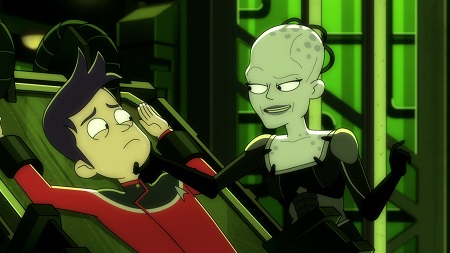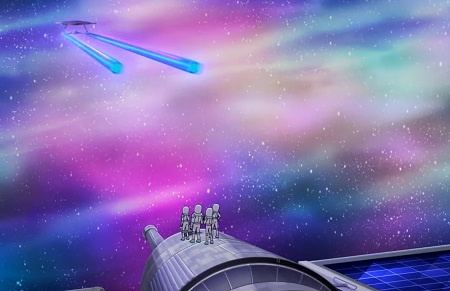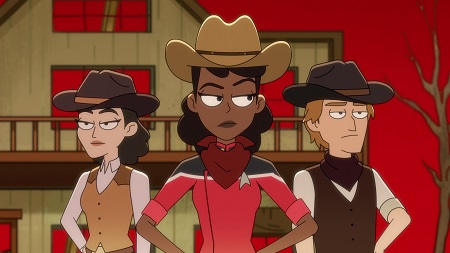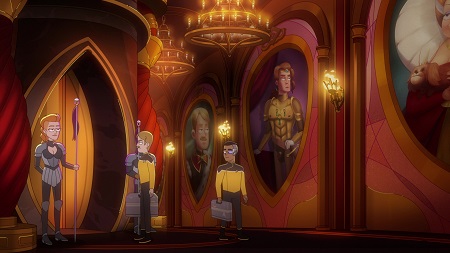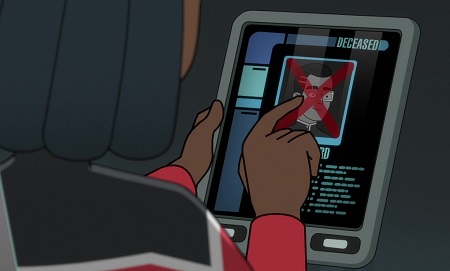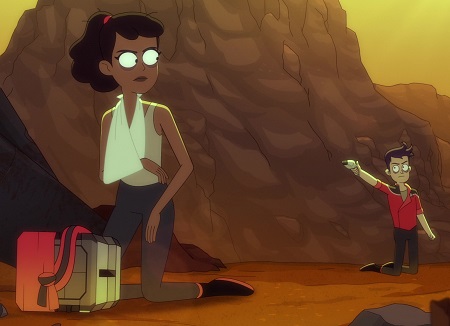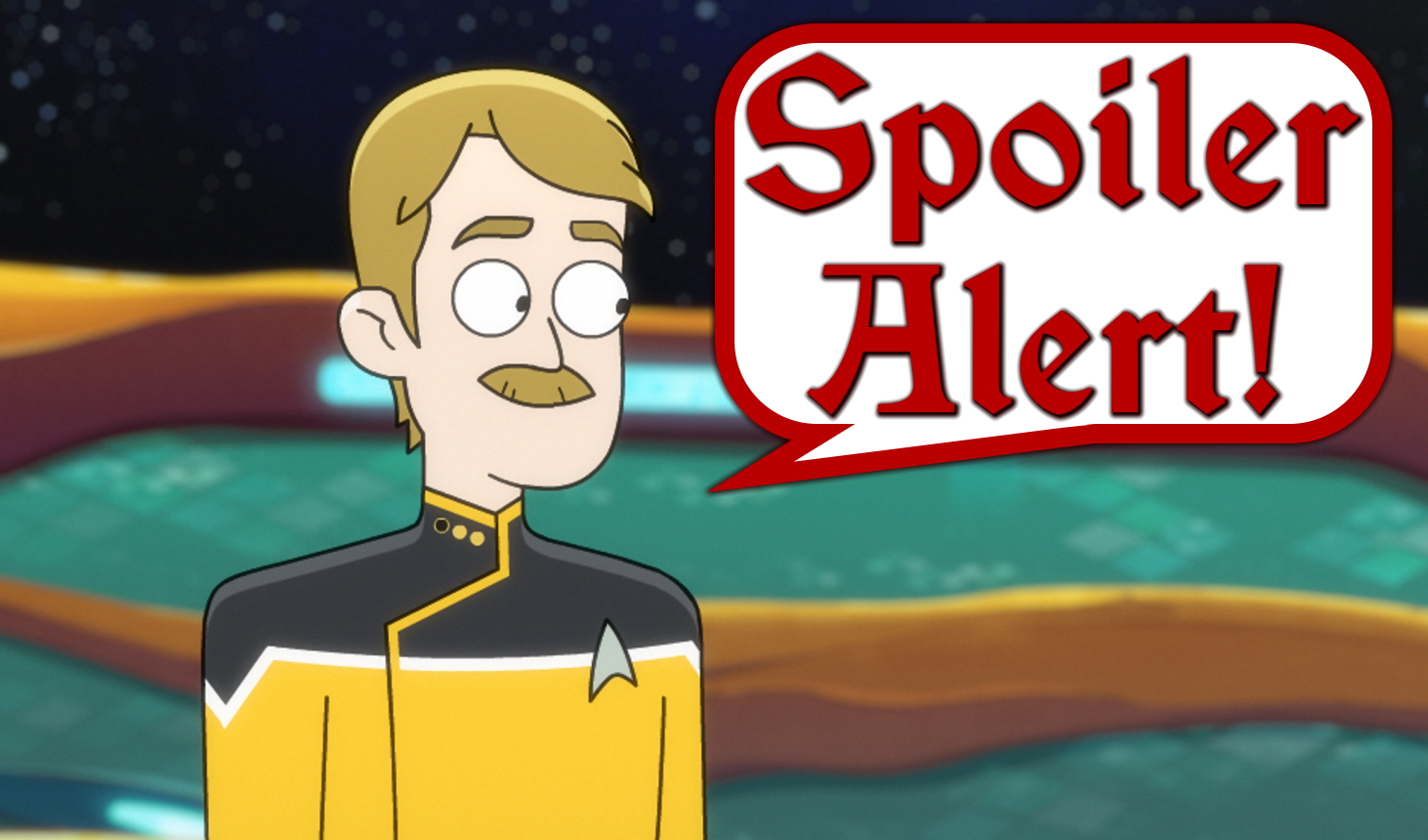
Spoiler Warning: There are spoilers ahead for Star Trek: Lower Decks Seasons 1-3.
Ah, it feels good to be doing this again! After a ten-month hiatus, Star Trek: Lower Decks is back on our screens with a ten-episode third season to take us all the way to Halloween! Although the season premiere didn’t quite hit the high notes that I was hoping for, it’s still great to welcome the series back. There’s been some big news about Lower Decks over the last couple of months – a crossover episode with Strange New Worlds is on the cards for next year, if you somehow missed that announcement.
After Season 2 ended on a cliffhanger with an incredibly powerful episode, I was hoping that this new season would bolt out of the gate and keep the quality high. Unfortunately, Lower Decks’ tendency to go for the non sequitur ending meant that the season premiere, while fun and entertaining at first, fell flat as it reached its conclusion. A well-established cliffhanger that ended Season 2 was wrapped up in an odd and ultimately unsatisfying way, with all of the significant events taking place off-screen. While we got a fun adventure with our favourite ensigns that took up the first four-fifths of the episode, the ending let it down massively.
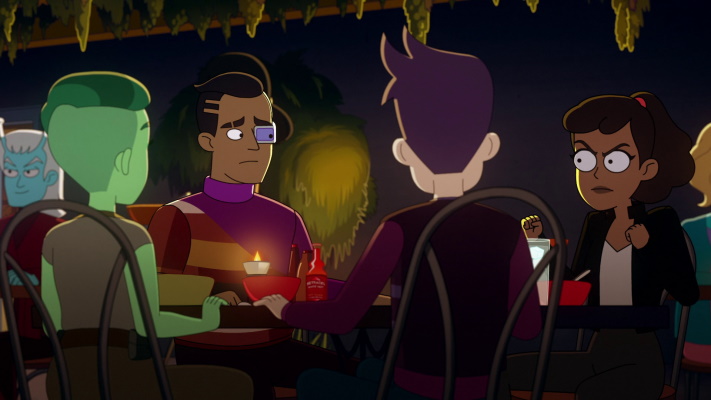
Grounded was an episode that was full of little nods and references to past iterations of Star Trek, and I certainly appreciated that. It was fun to get a look at Bozeman, Montana as it appears in the 24th Century, for example – including the infamous statue of Zephram Cochrane that we first heard about in First Contact. The outfits worn by the main characters recalled past Star Trek stories, including Rutherford’s Jake Sisko-inspired jumper and Boimler’s vest, which was first seen adorning Wesley Crusher in The Next Generation.
There was some gentle poking fun at Disneyland and Disney World in the presentation of the Bozeman, Montana complex, and that was certainly cute. The Phoenix “ride” that the ensigns hijacked to take to the Cerritos reminded me of the ride Star Tours at Disney World, particularly in the queue area. And the churros that Rutherford and Tendi were seen snacking on are likewise a Disney Parks staple!
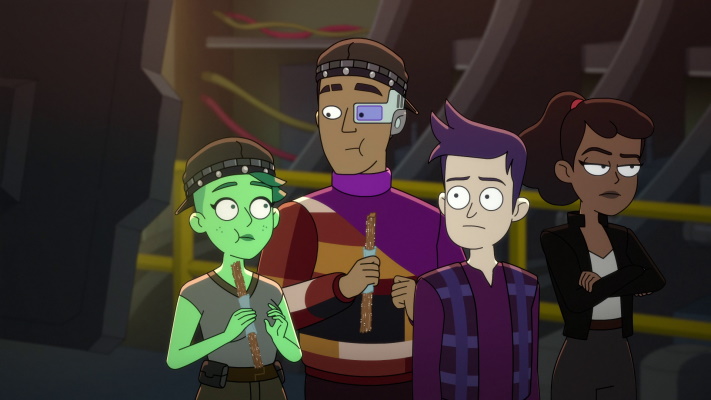
Back to Star Trek, we had callbacks to and parodies of the Picard family vineyard – which has most recently appeared, of course, in both seasons of Star Trek: Picard, though here it was seen closer to its appearances in Family and All Good Things. Sisko’s Creole Kitchen – the family restaurant operated by Benjamin Sisko’s father Joseph – was the setting for one scene, and we also got name-drops of Tuvok and Captain Bateson (the character played by Kelsey Grammer in The Next Generation Season 5 episode Cause and Effect) during Captain Freeman’s truncated explanation of her trial and the events leading up to it.
Finally, and this was a neat inclusion, James Cromwell reprised his role as Zephram Cochrane – albeit in holographic form. The musical sting from First Contact brought a tear to my eye, and the launch of the Phoenix was an incredibly neat sequence. The addition of a random theme park guest (and a cowardly one at that) kind of detracted from the moment a little, but that was a classic Lower Decks move in its own way and one I can’t really hold a grudge against.
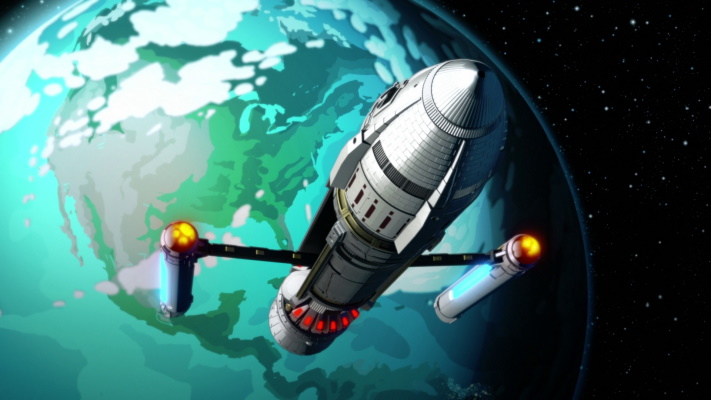
Once we’ve finished wading through the nostalgia, though, I’m left feeling that Grounded was a little hollow; an episode of false starts and setups that led nowhere – or to a disconnected, unpredictable conclusion that may have been “trademark Lower Decks” in some respects, but where the execution of its final twist and closing moments left a bit of a sour taste.
At first, Ensign Mariner seemed to be on a quest driven by emotion. But that emotional setup didn’t go anywhere, and her relationship with her mother arguably ends the episode in a worse place than it had been at the start. There seemed to be a story about Starfleet’s trustworthiness that could’ve harkened back not only to stories like The Search for Spock but that also could have connected with themes in recent seasons of Discovery and Picard – but it also didn’t go anywhere. And there was the fear that Ensign Mariner had that Captain Freeman was being mistreated because of her “lowly” status as captain of a California-class ship. That concept also hit the wall.
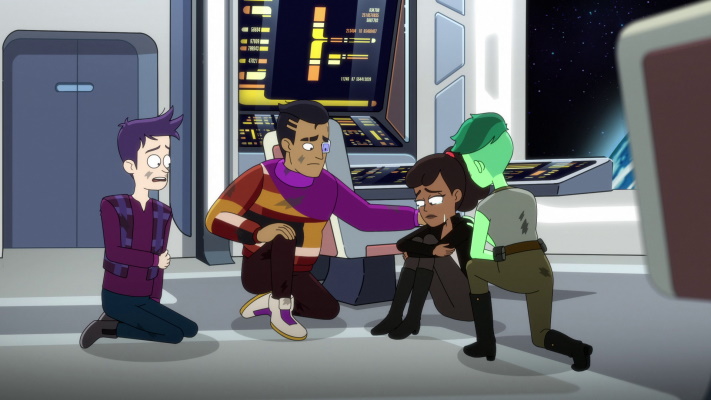
Then there was a particularly harsh judge for Captain Freeman’s trial who was mentioned once, never seen on screen, and whose influence appears to have had no impact whatsoever on the story. Boimler’s logs turned out to be unusable because of their content. That joke wasn’t even especially funny – yet it was the punchline of a whole chapter of the story, one that ended up going nowhere as a result. These are just some of the false starts and red herrings that Grounded threw at us.
The problem with these ideas isn’t that any of them are bad – it’s that Grounded threw them all out and then paid off none of them in a significant way. The idea of Starfleet being biased, or of a “conservative court” picking on officers from lower positions are both really neat concepts that even a comedic series like Lower Decks could have explored… but it seems to have dropped them just as soon as it had picked them up.

The first three-quarters of the episode did a decent enough job at setting up Mariner’s grief and fear, but the culmination of this storyline was far too short and one sequence on the bridge of the Cerritos wasn’t enough of a pay-off. When the rest of the ideas introduced to us in the first part of the episode went nowhere, there was basically nothing left and no way to salvage the story. Grounded’s “big twist” was that Captain Freeman was acquitted at her trial with no input from Mariner or the other ensigns, but it was just… nothing. It wasn’t especially clever, it certainly wasn’t funny, and the fact that it was rushed through with a brief montage to explain what really happened just felt incredibly anticlimactic.
Worse, Grounded picks up an unfortunate trend from earlier in Lower Decks’ run. By encouraging us as the audience to get invested in the ensigns’ story and believe that they were on a Search for Spock-type last-ditch mission to save their captain, only to turn around and show us that she was never in any real danger and didn’t even need their help, the show and its creators almost feel like they’re laughing at us. As if the audience’s investment in the story they set up is part of the joke. I noted this with disappointment in Season 1’s Veritas, and it’s a shame to see this unfortunate trope reoccur now that Lower Decks is entering its third season. The show should aim to be better than this.
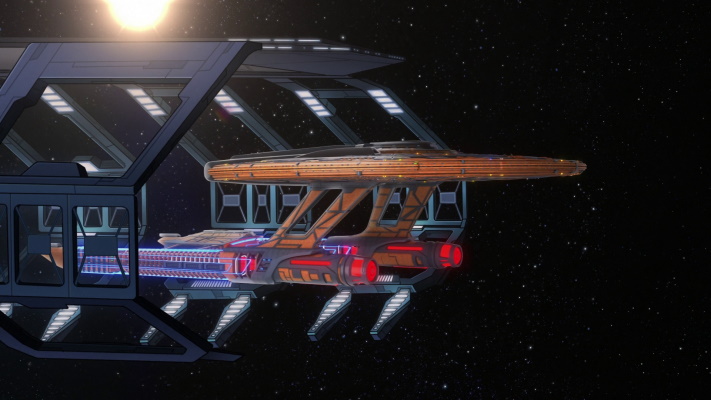
When Captain Freeman walked through the shuttlebay doors, flanked by her senior staff, I admit it was a surprise. But it didn’t feel real – I felt sure that she’d turn out to be a hologram, a changeling, a disguised Pakled… basically anything else other than the real, newly-freed captain. And the reason for that is simple: the story doesn’t flow. This conclusion is, as I said at the beginning, a non sequitur; it doesn’t follow on naturally from the story we’ve spent the rest of the episode following. And for some people, maybe this kind of twist works. For me, it didn’t. And when the entire episode is built around this one big, explosive moment, its failure condemns the entire episode.
Perhaps that last statement was a tad harsh. There are neat moments across the first portion of Grounded that really plucked the right nostalgic strings, and others that were amusing in one way or another. I liked, for example, the kindly old man who operated the transporter, and how none of the ensigns had the heart to stun him and tie him up. That was a fun way to throw in a twist to what felt like a predictable storyline.

However, all of those neat moments feel soured by the episode’s ending. Partly this is because going back and rewatching a story with a bad ending always feels like a tainted experience, but also it should be said that it feels like some of these moments were wasted time. Captain Freeman blitzed through a montage and explanation of the Pakleds’ scheme and her trial that lasted barely a minute, and perhaps a longer sequence – that could have included flashbacks to the trial itself and/or the events surrounding it – might’ve gone some way to making up for the rug-pull. I’m not sure that would’ve saved Grounded, but maybe the episode could have been transformed from a disappointment into something merely underwhelming.
Had the Captain Freeman reveal been made at the halfway point, instead of three minutes before the credits rolled, more time could’ve been dedicated to explaining her situation, she and Mariner could’ve enjoyed a longer conversation to process what happened, and some of the ultimately unnecessary fluff could’ve been cut from earlier in the story.
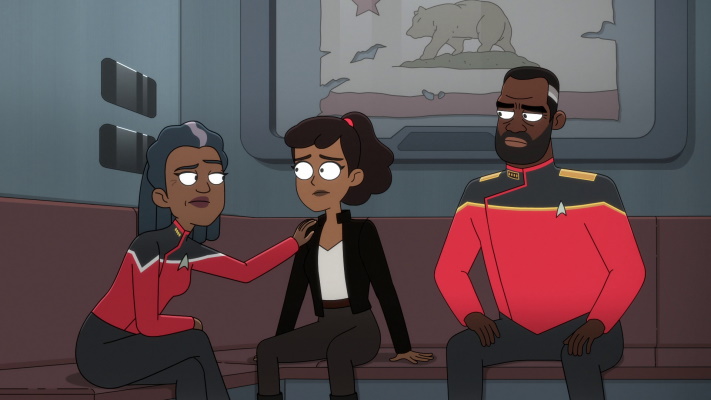
So I’m sorry to say that Lower Decks continues a trend of season premieres that don’t hit the high notes that we know the series can reach. Grounded was undermined by the decision to have the ensigns’ story not matter – and while, in some ways, that’s the point of Lower Decks as a whole, the way in which it was executed here is what let it down. I don’t mind following the ensigns as they follow orders, complete insignificant tasks, and the like… but setting up a story in which they seemed to be on a dangerous adventure only to yank it away at the last minute and show how pointless it all was, well that just doesn’t make for a fun, worthwhile, or entertaining ride. At least not for me.
Star Trek references dripped from every orifice in Grounded, but the inclusion of so many locations, characters, callbacks, and name-drops couldn’t save an episode that was, unfortunately, spoiled by a poor ending. After First First Contact had set up Season 3 for greatness, this first episode feels like a swing and a miss from Mike McMahan and the team.
Star Trek: Lower Decks Seasons 1-3 are available to stream now on Paramount+ in the United States and on Amazon Prime Video in the United Kingdom and around the world. The Star Trek franchise – including Lower Decks and all other properties discussed above – is the copyright of Paramount Global. This article contains the thoughts and opinions of one person only and is not intended to cause any offence.







